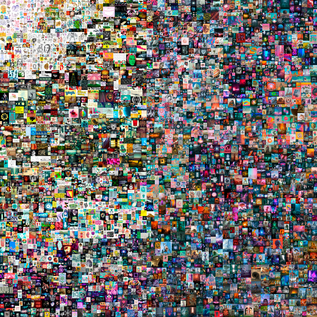Related Research Articles

A collectable is any object regarded as being of value or interest to a collector. Collectable items are not necessarily monetarily valuable or uncommon. There are numerous types of collectables and terms to denote those types. An antique is a collectable that is old. A curio is something deemed unique, uncommon, or weird, such as a decorative item. A manufactured collectable is an item made specifically for people to collect.

A certificate of authenticity (COA) is a seal or small sticker on a proprietary computer program, t-shirt, jersey, or any other memorabilia or art work, especially in the world of computers and sports. It is commonly a seal on paper authenticating a specific art work which and is made to demonstrate that the item is authentic.

Ethereum is a decentralized blockchain with smart contract functionality. Ether is the native cryptocurrency of the platform. Among cryptocurrencies, ether is second only to bitcoin in market capitalization. It is open-source software.
A decentralized autonomous organization (DAO), sometimes called a decentralized autonomous corporation (DAC), is an organization managed in whole or in part by decentralized computer program, with voting and finances handled through a blockchain. In general terms, DAOs are member-owned communities without centralized leadership. The precise legal status of this type of business organization is unclear.

Sarah Zucker, born 1985, is an American visual artist and writer based in Hollywood, Los Angeles. She specializes in mixing contemporary digital techniques with older analog approaches as well as the use of VHS. Zucker is considered a pioneer of crypto art, releasing digital editions of her video art as non-fungible tokens since 2019.

CryptoKitties is a blockchain game developed by Canadian studio Dapper Labs. The game allows players to buy, sell, and create NFTs using on Ethereum. These NFTs represent virtual cats. The game's popularity in December 2017, congested the Ethereum network, causing it to reach an all-time high in the number of transactions and slowing it down significantly.

A non-fungible token (NFT) is a unique digital identifier that is recorded on a blockchain and is used to certify ownership and authenticity. It cannot be copied, substituted, or subdivided. The ownership of an NFT is recorded in the blockchain and can be transferred by the owner, allowing NFTs to be sold and traded. NFTs can be created by anybody and require few or no coding skills to create. NFTs typically contain references to digital files such as artworks, photos, videos, and audio. Because NFTs are uniquely identifiable, they differ from cryptocurrencies, which are fungible.

Leopoldo D'Angelo, better known by the pseudonym "Dangiuz" is an Italian contemporary visual artist, digital artist and art director specializing in sci-fi themes. His work has been featured in art networks, books, TV channels and magazines such as RAI, Arte, Wallpaper*, NVIDIA Studio Standouts, Juxtapoz Magazine, Sohu, Pixiv and Digital Production, and showcased in various museums and galleries worldwide. He also took part in the creation of Rui Hachimura's Cherry Blossom kimono design and Maserati's MC20 concept art.
Sorare is a fantasy sport cryptocurrency-based video game. It was developed in 2018 by Nicolas Julia and Adrien Montfort. There are 3 sports in Sorare: football, basketball, and baseball. It is available for Android, iOS and web browsers.

CryptoPunks is a non-fungible token (NFT) collection on the Ethereum blockchain. The project was launched in June 2017 by the Larva Labs studio, a two-person team consisting of Canadian software developers Matt Hall and John Watkinson. The experimental project was inspired by the London punk scenes, the cyberpunk movement, and electronic music artists Daft Punk. The crypto art blockchain project was an inspiration for the ERC-721 standard for NFTs and the modern crypto art movement, which has since become a part of the cryptocurrency and decentralized finance ecosystems on multiple blockchains.

Michael Joseph Winkelmann, known professionally as Beeple, is an American digital artist, graphic designer, and animator known for selling NFTs. In his art, he uses various media to create comical, phantasmagoric works that make political and social commentary while using pop culture figures as references. British auction house Christie's has called him "A visionary digital artist at the forefront of NFTs". Beeple was introduced to NFTs in October 2020 and credits Pak for providing his first "primer" on selling NFTs. The NFT associated with Everydays: the First 5000 Days, a collage of images from his "Everydays" series, was sold on March 12, 2021, for $69 million in cryptocurrency to an investor in NFTs. It is the first purely non-fungible token to be sold by Christie's. The auction house had previously sold Block 21, an NFT with accompanying physical painting for approximately $130,000 in October 2020.

Everydays: the First 5000 Days is a digital work of art created by Mike Winkelmann, known professionally as Beeple. The work is a collage of 5000 digital images created by Winkelmann for his Everydays series. Its associated non-fungible token (NFT) was sold for $69.3 million at Christie's in 2021, making it the most expensive non-fungible token ever.

Prince Jacon Osinachi Igwe, commonly known as Osinachi, is a Nigerian visual and digital artist. He is known for using Microsoft Word as his medium. Described as "Africa's foremost crypto artist," Osinachi is regarded as the first African artist to have his work digitally auctioned as an NFT by Christie's in Europe."
A rare Pepe or RarePepe is a variation on the "Pepe the Frog" internet meme, itself based on a character created by Matt Furie. The related Rare Pepe crypto project, created by various artists worldwide between 2016 and 2018, was based on the aforementioned meme and traded as non-fungible tokens (NFTs) recorded on the CounterParty platform. A total of 1,774 official cards were released for the project across 36 series.

Pak, formerly known as Murat Pak, is a digital artist, cryptocurrency investor, and programmer. Pak is known for creating the curation platform Archillect, an internet bot which reshares media based on user interactions with content hosted on various social platforms and for launching a platform for burning NFTs to receive tokens of the cryptocurrency Ash.

Olive Allen is a New-York based visual artist, associated with crypto art movement. She has been releasing her digital artworks as non-fungible tokens since 2019.

Bitchcoin is a non-fungible token (NFT) on the Ethereum blockchain. The project was launched in early 2015 as a fork of Bitcoin, several months before the launch of Ethereum. Bitchcoin was originally backed by the artist Sarah Meyohas' photography at a fixed rate of one token to 25 square-inches of one of the artist's photographs. This was one of the first instances of a physical work of art being put on a blockchain.

The ERC-721 Token Standard, is a technical framework, defining a set of rules and interfaces for creating and managing unique, non-fungible tokens (NFTs) on the Ethereum blockchain. The blockchain game featuring digital artworks known as CryptoKitties is credited with pioneering ERC-721 when it achieved mainstream attention shortly after its launch in 2017.
William "Will" Entriken, also known by the online moniker Fulldecent, is a solutions architect, cybersecurity specialist, financial analyst, general manager, and civic hacker best known for his contributions in blockchain technology and open sourced solutions. He is recognized as the lead author of the landmark Ethereum paper ERC-721: Non-Fungible Token Standard, published in 2018. This paper is recognized for pioneering the foundation of the digital collectibles eco-system by establishing a programming standard called "ERC-721" to create NFTs via smart contracts on Ethereum. It also first formalized and defined the term Non-Fungible Token (NFT) into blockchain nomenclature which was made popular by the blockchain game CryptoKitties; the CTO of that game, Dieter Shirley, is also a fellow co-author of the published paper.
References
- 1 2 León, Riley de (2021-10-01). "Doodles used to create Gary Vaynerchuk NFT collection sell for $1.2 million in Christie's auction". CNBC. Retrieved 2021-12-07.
- ↑ Gonzalez, Oscar. "You can get a free DC x Palm NFT tomorrow. What to know about the digital tokens now". CNET. Retrieved 2021-12-05.
- ↑ "Smart Contract Audit for Curio Cards" (PDF). Retrieved 2024-02-07.
- 1 2 3 4 Nover, Scott (October 2021). "Early NFT collection Curio Cards makes its debut at Christie's". Quartz. Retrieved 2021-11-28.
- ↑ "Christie's Is Now Accepting Ether in Exchange for Ethereum's Earliest NFTs". Observer. 2021-09-21. Retrieved 2021-11-28.
- ↑ "The Results of Christie's Eclectic 'Postwar to Present' Auction Shows Today's Buyers Have a Speculative Eye and a Nose for Novelty". Artnet News. 4 October 2021. Archived from the original on 2021-10-04. Retrieved 2021-11-28.
- ↑ "Non-Fungible Tokens: How 'Punk' Crypto Trend Gave Rise To NFTs For Digital Art". IndiaTimes. 2021-09-05. Retrieved 2021-11-28.
- ↑ "Art Industry News: On a Quest to 'Spread Korean Culture Through the World,' K-Pop Superstars BTS Offer a Gift to the Met + Other Stories". Artnet News. 21 September 2021. Archived from the original on 2021-09-22. Retrieved 2021-11-28.